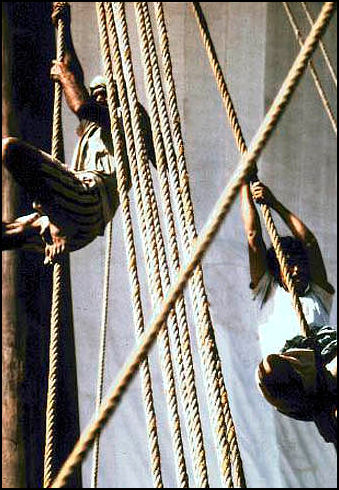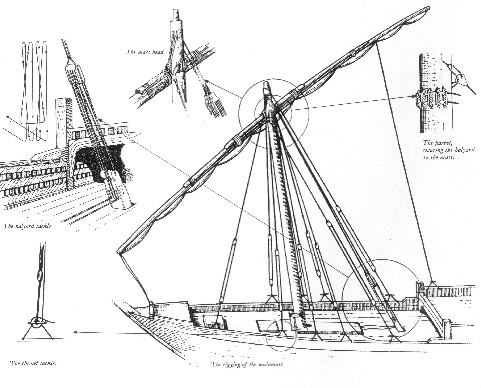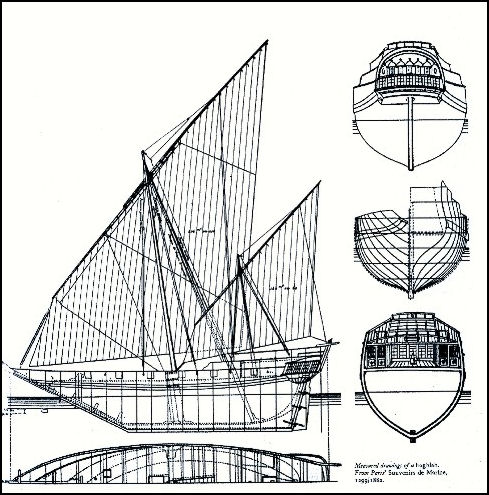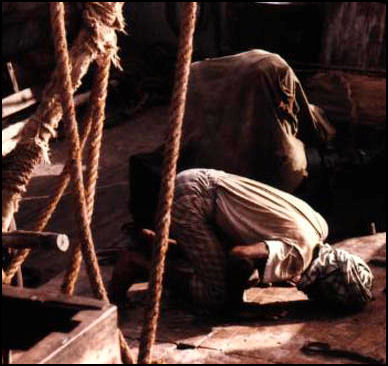DHOWS

Dhows are sailing vessels with lateen sails that have been used by Arab sailors in the the Persian Gulf, Arabian Sea and the Indian Ocean for over 2000 years, on what may be the world’s oldest continually run commercial sailing route. The following information is mostly about modern dhows but much of also applies to dhows used centuries ago. [Source: Marion Kaplan, National Geographic, September 1973]
Utilizing the monsoons they have carried goods from the Middle East to India in the winter and from India to the Middle East in the summer. Dhows also brought slaves and ivory from ports in East Africa, such as Mogadishu, Mombasa, Lamu, Zanzibar and Dar Es Salaam to Kuwait and Abu Dhabi on the Persian Gulf. Dhows carried slaves until the 19th century.
The dhows used today are not all that different from the ones said to have been used by Sinbad the Sailor in "The Thousand and One Nights". Allen Villiers wrote in his book "Sons of Sinbad": “As a pure sailing craft carrying on in their unspoiled ways, only the Arab dhow remained. Only the Arab remained making voyages as he always had, in a wind-driven vessel sailing without the benefit of engines. Only the Arab still sailed his wind ships over the free sea, keeping steadfastly to the quieter ways of a kinder past...the Arab dhow was the proud last remnant of the romantic East.”
Dhows usually have one or two masts. Most large dhow have two masts, the largest of which is as wide as the ship is long, supporting a scimitar-shaped linen sail. Some have elaborately caved sterns, reminiscent of Spanish galleons, and for a time rocket ships were popular bow ornaments.
The large lantern sails are still used in the monsoon winds, but most modern dhows rely on diesel motors. A dhow with a 165 horsepower engine can cover about 200 miles in a day.
Good Websites and Sources on the Silk Road: Silk Road Seattle washington.edu/silkroad ; Silk Road Foundation silk-road.com ; Wikipedia Wikipedia ; Silk Road Atlas depts.washington.edu ; Old World Trade Routes ciolek.com;
RELATED ARTICLES IN THIS WEBSITE: SILK ROAD factsanddetails.com; SILK ROAD EXPLORERS factsanddetails.com; SILK ROAD: PRODUCTS, TRADE, MONEY AND SOGDIAN MERCHANTS factsanddetails.com; SILK ROAD ROUTES AND CITIES factsanddetails.com; MARITIME SILK ROAD factsanddetails.com; MARITIME-SILK-ROAD-ERA SHIPS, EXPORT PORCELAINS AND SHIPWRECKS factsanddetails.com
RECOMMENDED BOOKS: “Fujian in the Sea: Fujian and the Maritime Silk Road” (Illustrated Fujian and the Maritime Silk) by Shuoxuan Chen and Bizhen Xie Amazon.com ; “When Silk Was Gold: Central Asian and Chinese Textiles” by Metropolitan Museum of Art, Anne Wardwell, et al. Amazon.com ; “The Silk Roads: A New History of the World” by Peter Frankopan, Laurence Kennedy, et al. Amazon.com; “The Silk Road: A New History” by Valerie Hansen Amazon.com; “Empires of the Silk Road: A History of Central Eurasia from the Bronze Age to the Present” by Christopher I. Beckwith Amazon.com; “Life Along the Silk Road” by Susan Whitfield Amazon.com; “Fujian in the Sea: Fujian and the Maritime Silk Road” (Illustrated Fujian and the Maritime Silk) by Shuoxuan Chen and Bizhen Xie Amazon.com ; “When Silk Was Gold: Central Asian and Chinese Textiles” by Metropolitan Museum of Art, Anne Wardwell, et al. Amazon.com ; “The Travels of Marco Polo” by Marco Polo and Ronald Latham Amazon.com
Types of Dhows
The first dhows were simple dugouts with teak planks sewn to their sides. Over time larger vessels were developed that employed a keel on which the planks were sewn.
There five major kind of dhows are: 1) the “Sambuk”, used for pearling, fishing and transporting pilgrims to Mecca; 2) the “boom”, a vessel built in Bahrain, Oman and Kuwait, and considered the most seaworthy vessel; 3) the “baggala”, the largest dhow, once used to transport slaves and ivory but rarely seen anymore; 4) the “badan”, a small craft with a shallow draft; and 5) the “ghandaj”, a large vessel with a curved stern used on the Arabian Sea for transporting dates, Persian Gulf pearls, timber and smuggled silver.
The boom is a double-ended craft with a hull shape that predates the 16th century. It is believed the designs for these ships originated in Bahrain and spread to place like Oman where they were used for trade with India and Africa. The largest of the traditional Arabian vessels, the boom can carry up to 40 tons and reached lengths of a 40 meters. The key feature of the design is a long straight planked bow-sprit, angled at about 45 degrees.
The “sambouk” is one of the most graceful and evocative ships. It possesses a low finely tapered bow and a high transom stern. In the past it was the favored pearling vessel. Now it is use mainly for fishing and trading.

dhow rigging
Dhow Materials and Features
Large seaworthy dhows have a teak hull with ribs of timber for reinforcement and strength and are held together with cement paste and plugged with cotton strips soaked in fish oil and caulked with whale or shark oil.
The preferred wood for the ribs and keel has been teak or a similar wood. The hand-hewn keel usually have come from a giant log from a single tree. Teak and coconut-palm wood have been favored for masts and spars. Teak has been prized in shipbuilding because it was strong and resistant to sea worms. In the old days It was harvested in forests in India and Southeast Asia.
Dhows were sewed together. The timbers were lashed together with ropes made of coconut fibers rolled and twisted by hand. No nails were used. There was a belief that the oceans floor was a giant magnet that would suck out nails. The art of sewing a ship together remains alive on Agatti Island in Lakshadweep off the southwest coast of India.
Coconut ropes are made from the husk sof coconuts rotted in sea water (not fresh water), pounded with wooden mallets (not iron hammers which weaken the fiber), and spun by hand (rope made machines is not strong enough). Some ships had metal fasteners. Metal is more durable than coconut rope and was better on fighting ships for securing guns.
Lavatories were often “balconies “slung over the stern “like theater boxes” or a hole in the deck in the back of the vessel. Showers consisted seawater drawn with a bucket and dumped over oneself.
The triangular lateen sails on dhows have traditionally been made from woven palm leaves, coconut fiber, reeds or cotton. Vessels with lateen sails are faster and more maneuverable than than ships with square-rigged sails. Lateen sails copied from dhows were used on European explorer ships.
Large dhows include a keelson, a reinforcing timber fastened directly to the top of the keel to hold the edges of the garboards (the planks next to keel) in place.

a baggala
Dhow Building
Dhows are made using the shell-building method in which vessels are created one plank at a time. Modifications can be made in the middle of construction by altering the shape of the planks or the angles of attachment. By contrast, European ships have traditionally been built using the frame-first method which allows much less alteration once construction has begun.
Some large dhows are still made almost completely by hand. Arabs making the hull prefer working with razor-sharp adzes. Indians prefer soft-iron chisels which allow them cut the curves of the planks and make the complicated joints for the great beams.
Dhow building passed has traditionally been passed down father to son and ships have been made with no blueprints. Timbers are shaped with hand tools. Experienced shipbuilders construct the vessel with no plan except for what is in their head and no way of making sure the pieces are plumb and level except for what they measure with their eyes and ancient plumb lines.
During construction, dhows are temporarily held together with wooden cleats nailed across the seams, and often supported by frames bolted to the keel. After construction is finished, the vessel is allowed to sit for a couple weeks to allow the timbers to settle.
Sealing and Preserving a Dhow Hull
Large ships have 20,000 holes for the coconut rope fasteners bored in them by hand with a bow drill. The rope is threaded by special craftsmen and the holes are plugged on the inside with coconut husks or dowels and the outside is sealed a waterproof mix of lime and tree gum. The coconut rope is swabbed with vegetable oil to preserve it. These days nail fastenings are often used and shark oil is rubbed over all the metal parts to preserve them.
Below waterline the hull is rubbed with goat fat and lime to discourage worms and barnacles. Above waterline shark oil or fish oil is used as a preservative. If a ship is regularly oiled it will last 60 to 100 years. By contrast nailed ship will go for only ten years before the nails have to be replaced.
Dhow Crews

praying towards Mecca
Traditionally a dhow was captained by a ship master with a crew of ten shipmates, most of whom dressed in turbans or head clothes, sarongs and robes. Most were Muslims who dutifully bowed and direct their prayers towards Mecca five times a day.
Dhow crews have traditionally had little sense of time and spent much of their time lying around chatting, dozing, smoking tobacco or hashish through a hookah, listening to or making Arabesque music, chewing qat, making and drinking sweet tea and making baskets. Passengers were traditionally asked to pay a goat for each voyage.
If there was work to do the crew would suddenly jump and do it. The crew followed orders of the ship master instantly and often chanted and sang as they did their chores.
Some captains who have been sailing for decades still can’t read a map. Many captains make sure their crews are from different villages so they don’t gang up on him.
Describing Omani sailors, Time Sevrin wrote in National Geographic, “They settled easily into the rhythm of shipboard life. They chatted, sang traditional songs, rigged fishing lines in our wake, and dozed. They could sleep anywhere, stretched out on deck with their turbans unwound and draped over their faces for shade. Yet whenever there was work to be done, they laid into the job with zest.”
When asked what he does if his dhow appears to be going down, one captain told the New York Times: “We strap planks to the plastic barrels and wait to get picked up.”
Dhow Supplies
Dhows have traditionally carried only a pair of compasses and a sextant for navigation tools. In the old days, dhows carried a “kamal”, a navigation devise that could determine latitude based on the height of the North Star above the horizon.
Food included unleavened bread, rice, goat stew, and ghee (clarified butter). Fresh fish were caught with a half dozen or so lines that hung off the boat. Dhows have traditionally carried surprisingly little drinking even though they sailed in areas with stifling heat and humidity.
Inventories were recorded on leather strings with knots denoting units of 20. The crew often slept out on the deck, wrapping themselves with blankets if it rained. Some have coconut matting on the rails to keep the crew from being splashed by waves.
Dhow Cargoes
During the Silk Road era dhows made it as far as China and Indonesia and traded linen, cotton, woolen clothes, metalwork and iron ore from the Middle East for silks, camphor, musk and spices from Asia. Today the are often used to transport tourists, ferry people short distances and smuggle stuff.
When a dhow brings goods to a town or village without a harbor surfboats are used to transport the goods to the beach. Some of these boats are fashioned from planks sewn together with fiber.
Dhows are disappearing as merchant vessels. They are still used in Africa and the Persian Gulf to ferry small quantities of goods, but as far large commercial loads of raw materials like sugar, tea, and coffee they are no match for large steel ships.
Image Sources: Marion Kaplan, Nabataea.com
Text Sources: New York Times, Washington Post, Los Angeles Times, Times of London, National Geographic, The New Yorker, Time, Newsweek, Reuters, AP, Lonely Planet Guides, Compton’s Encyclopedia and various books and other publications.
Last updated August 2021
